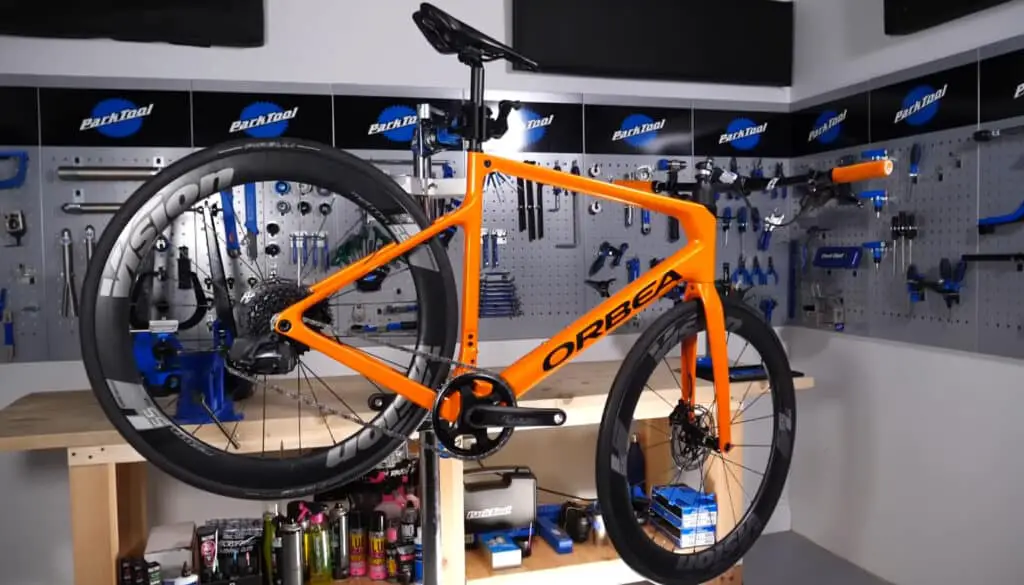Converting a road bike to a flat bar involves replacing the drop handlebars with a flat handlebar and changing the brake levers, shifters, and possibly the stem to accommodate the new handlebar. This process typically requires some mechanical knowledge and skill, and it’s essential to ensure that all new components are correctly installed and adjusted for optimal performance and safety.
Increasing comfort is one of the primary benefits of converting a road bike to a flat bar. Flat bars allow for a more upright riding position, which can be more comfortable for riders with back or neck issues.
The conversion process can also be expensive, especially if new components are needed. Okay, let’s have an in-depth discussion to learn every aspect of this conversion!
Why Do Road Bikes Have Drop Bars?
Road bikes have drop bars primarily because they offer multiple hand positions. This allows riders to change their grip and posture and reduce long-ride fatigue. The drop bars also allow for a more aerodynamic riding position, which is vital for road cycling, where speed and efficiency are essential.
When riding on the hoods (the curved portion of the drop bar), riders can maintain a more upright position for better visibility and control and improved comfort for the hands and wrists. When riding on the drops (the lower, straight portion of the bar), riders can lower their body and reduce wind resistance, which is especially helpful when riding into a headwind or at high speeds.
Ways To Convert Road Bike To Flat Bar
You’re in luck if you want to convert your road bike to a flat bar! This relatively straightforward process can be done in just a few steps. A flat bar can be more comfortable for some riders and provide a more upright riding position. Here are seven easy steps to help you convert your road bike to a flat bar:
First, Measure Your Bike’s Stem
Before converting your road bike to a flat bar, it is crucial to measure your bike’s stem accurately. Even the smallest changes can impact your bike’s functionality, so following an exact process is essential for a successful and easy conversion.
The first step is ensuring the new handlebars fit correctly within the stem clamp.
To do this, measure the diameter of the existing handlebar as a reference while choosing a new one. Typical flat bar diameters are 22.22 mm, 25.45 mm, 31.85 mm, and 35mm. If the desired handlebar has a broader diameter than the existing one, changing the stem clamp to a wider one is necessary. However, purchasing a combination of handlebars and stems can be a safer bet to avoid measurement issues.
Accurate measurement is crucial in conversion to prevent compatibility issues and accidents. Therefore, taking the proper measures before converting any part of the bike is important. A slight miscalculation in measurement can cause the entire conversion process to collapse.
Then Gather Your Tools
Before you get started, you’ll need to gather some tools. Here’s what you’ll need:
- Allen wrench set
- Flathead screwdriver
- Cable cutters
- Cable housing cutter
- New flat handlebars
- Stem (if necessary)
- Grips
- Brake levers
- Shifters
- New cables and housing (if required)
Start Removing the Existing Handlebars and Stem

To begin the conversion process, you’ll need to remove the existing handlebars and stem. First, loosen the stem bolts with your Allen wrench set. Then, gently tap the top of the stem with a rubber mallet to release it from the steerer tube. Once the branch is free, you can remove the handlebars.
Install the New Stem
If your new flat handlebars have a different diameter than your old handlebars, you’ll need to install a new stem. To do this, slide the new stem onto the steerer tube and tighten the bolts with your Allen wrench set.
Install the New Handlebars
Slide the new handlebars onto the stem and tighten the bolts with your Allen wrench set. Be sure to adjust the handlebars so they’re in a comfortable position for you. Also, you need to select the appropriate handlebars for your bike. Here’s how:
To select the perfect handlebar for your bike, you should consider the following factors:
- Choose a handlebar that matches your shoulder width to ensure comfort and stability while riding.
- Look for handlebars with markings on the ends. These markings allow you to trim them down to get a narrower grip on aluminum or Chromoly flat bars.
- Remember that carbon fiber flat bars cannot be trimmed, so choose the width carefully.
- Consider the handlebar’s dimensions, including its rise, upsweep, or down sweep and width, to find the best fit for your riding style and needs.
- Remember that a flat bar is not entirely straight, so choose a handlebar with the right angle and height for your preferred riding position.
Install the Brake Levers and Shifters:
Slide the brake levers onto the handlebars and tighten the bolts with your Allen wrench set. Adjust the brake levers’ position so they’re comfortable for you. After that, Slide the shifters onto the handlebars and tighten the bolts with your Allen wrench set. Again, be sure to adjust the shifters’ position so they’re comfortable for you.
Then, Install the Grips
After sliding the grips onto the handlebars, use your Allen wrench set to snug up the bolts, holding them in place. Make sure the grips are adjusted to a comfortable position by making the necessary adjustments.
Lastly, Install the Cables and Housing (if Necessary)
If you’re using new cables and housing, you’ll need to install them next. Cut the housing to the appropriate length and slide it onto the wires. Then, slide the cables through the holes on the brake levers and shifters. Be sure to route the cables correctly and adjust the tension as necessary.
And that’s it! You can convert your road bike to a flat bar with just a few simple steps. Be sure to take your new setup for a test ride to ensure that everything is functioning correctly and that you’re comfortable with your new riding position.
Still Not Satisfied? Don’t Worry! Some Tips Are Here!
Adjust the handlebar height:
Adjusting the handlebar height may improve your comfort and overall satisfaction depending on your preferred riding position. You can change the stem or add spacers to raise or lower the handlebar.
Change the handlebar shape:
Flat bars come in different shapes; another form provides a more comfortable and stable grip. Consider trying a different shape, such as a riser or bullhorn handlebar.
Upgrade the components:
Upgrading your bike’s components, such as the brakes, drivetrain, or wheels, can significantly improve your riding experience and overall satisfaction.
Get a professional bike fitting:
A professional bike fitting can help you determine the best handlebar position and overall fit for your body type and riding style, improving your comfort and satisfaction.
Note: Finding the optimal setup for your bike may take some trial and error. Feel free to experiment and adjust until you find what works best.
Benefits of converting Road Bike To Flat Bar
Changing a road bike to a flat bar has several advantages, particularly for riders seeking a more relaxed and pleasant ride. The flat bar’s top edge promotes a more natural and comfortable upright riding posture. Riders with back, neck, or shoulder difficulties may benefit the most from this feature. If you’re sitting up straight, you won’t strain your spine, pelvis, and hips as much, making the ride more bearable. Having your body upright also increases your visibility, which may help keep you safer when driving.
Switching from a road bike to a flat bar may improve control and stability. Flat bars provide a broader grip, which may improve the bicycle’s leverage and control. This is useful for any cyclist but especially beneficial for those who go off-road or often bike over rugged terrain. The extra grip may be a lifesaver when going slow or squeezing into a small spot.
Changing the handlebars on a road bike to flats makes it more maneuverable. Since flat bars have a broader sweep and shorter reach than drop bars, they are often more convenient for use in confined locations like corners. Those who want to ride in metropolitan areas or wish to better control their bikes, in general, may benefit from this.
Changing the handlebars of a road bike to a flat design could increase comfort, stability, and handling. Nevertheless, there might be drawbacks, such as decreased speed or worse aerodynamics. On the other hand, a flat bar conversion is ideal for riders who value convenience and simplicity of use above speed and performance.
Cost To Convert Drop Bar To Flat Bar
To compare the cost of converting a drop bar to a flat bar handlebar, here are some key points:
- The cost of converting a drop bar to a flat bar will depend on the quality of the parts you choose.
- The price range for a conversion kit can vary, with the cheapest options starting at around $20 and more expensive options reaching up to $100.
- The conversion cost will generally include the handlebars, necessary cables, brake levers, shifters, and grips.
- Remember that there may be additional costs if you choose to have a bike shop do the conversion for you, as they will likely charge for labor.
- While it may be tempting to go for the cheapest option, investing in higher-quality components can result in a better overall ride and increased durability over time.
The cost of converting a drop bar to a flat bar will vary depending on your preferences and the quality of the components you choose. However, options are available for various budgets, ranging from $20 to $100.
FAQ
Why would someone want to convert their road bike to a flat bar?
Converting a road bike to a flat bar style may be done for various reasons. Convenience is a significant factor. Riders with back or neck problems may find a more upright posture on the bike with flat bars.
What are the potential downsides of converting a road bike to a flat bar?
Changing the handlebars of a road bike to a flat bar setup could decrease the bike’s aerodynamic efficiency and peak speed. And since fewer hand positions are available on flat bars than drop bars, riders may experience hand fatigue on rides over an hour.
Can any road bike be converted to a flat bar?
Most road bikes may have handlebars changed to a more conventional flat design. However, you should check whether the new flat bar parts work with your bike’s current parts. Installing a flat bar on a road bike may require further adjustments to the frame.
Is it easy to convert a road bike to a flat bar?
Converting a road bike to a flat bar style does take some mechanical aptitude and familiarity with the bike’s parts. All new components must be fitted and adjusted correctly to guarantee security and peak performance.
Will converting a road bike to a flat bar void the bike’s warranty?
Depending on the road bike’s original manufacturer’s regulations, converting it to a flat bar may render the original warranty null and invalid. Before making any changes, verify with the manufacturer or a local bike shop that your warranty will remain in effect.
Is it possible to transform a flat bar into a drop bar?
Nevertheless, more work and parts may be needed to transform a flat bar into a drop bar again. It’s also crucial to check that the bike’s new parts are compatible with its current ones.
Finally, Here Are Some Additional Tips:
- When choosing your new flat handlebars, be sure to select a width that’s appropriate for your body size and riding style.
- If you’re uncomfortable adjusting the tension on your brakes and shifters, you should take your bike to a local bike shop for assistance.
- If you’re using new cables and housing, lubricate them before installing them to ensure smooth shifting and braking.

I am Ryan Ford, a mountain biking enthusiast who loves to explore the outdoors. I also like to go on adventures with friends and anything else that involves being outside. I love my bike because it gets me out of the house and gives me an opportunity to enjoy nature.

